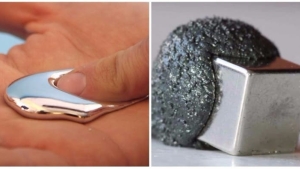14 incredible high-tech materials that are set to change the world
If you're a science or technology fan, then this one's for you. We've put together a list of 14 mind-boggling materials set to change our industrial landscape. Some are so awesome they seem to defy the laws of physics!

Did you know that you can float objects on a gas or that it only takes a feather-light touch to explode certain powders? Or what about the idea of 'intelligent wood'? If you think this sounds like science fiction, then read on!
1. Hydrophobic materials


Hydrophobic materials repel water, various other liquids and dirt. Once the stuff of science fiction, they're made from silicon dioxide and titanium nanoparticles and are currently used to waterproof a range of objects: shoes, clothes, tablecloths, gutters. They're also proving to be an effective way to mop up oil spills!
2. A gas that lets objects float

Hexafluoride, or SF6, is a magical gas on which objects can float and which doesn't escape even if you leave its container open. Its other amazing property? It can lower our voice! So if you like squeaking from helium, take a gulp of this and enjoy your best monster voice. One a more serious note, this gas is already being used in industry, the medical world and electrical installations. The only glitch is that it's a greenhouse gas that can cause problems when used in high concentrations for long periods of time, which is why its use is currently limited.
3. A metal that melts in your hand



We're used to metals that melt at high temperatures, but gallium goes one step further - this high-tech favorite melts at room temperature and when placed in hot water! Even more astounding is its ability to dissolve aluminum.
4. Highly explosive powder


Nitrogen triiodide is highly unstable. You just need to touch it and it will explode into a cloud of color, so don't try this one at home! Even if you think this could be fun, be warned that it's a dangerous substance that's not currently used in industry. For time being it's exploding on the internet, but has yet to find its technological niche.
5. A metal with a memory


Nitinol is a fascinating nickel and titanium alloy that returns to its original form if you heat it up after having changed its shape. For the non-scientists amongst us, the official term is shape-memory alloy or SMA.
6. Programmable wood

MIT (Massachusetts Institute of Technology) experts have come up with a 'programmable wood' that takes on a particular form when soaked in water. It's not made from a sophisticated alloy, but rather a wood laminate. It's produced using a 4D printer... putting 3D printers to shame in the process!
7. Hot ice


From the outside sodium acetate looks like normal ice, except that these 'ice cubes' are warm! It's often used in heat pads for folks who have to deal with glacial temperatures, as well as to boost the circulation of patients who need to have their blood drawn.
8. Hydrogel

Hydrogel is a polymer that can hold up to 200 times its weight in water before slowly releasing it. It's particularly useful in the horticultural world as it can slowly release large quantities of water, meaning that plants don't need to be frequently watered. It's also used in medicine.
9. Self-repairing materials


Although not a liquid metal, there are echoes of Terminator 2 with these amazing materials. When these materials are damaged, they liberate microcapsules of bacteria that fill and repair any cracks - in the same way that our skin heals itself! They're already being used for smartphone covers as well as in the building industry and medical world. There's even talk that one day they'll be used to build self-repairing roads. But not self-repairing T1000 humanoids!
10. A super strong material that's lighter than air


Aerogel has innovative properties that could be applied to numerous industries. It's transparent, hard, fire-proof and retains heat. It's also 7 times lighter than air and 500 times less dense than water. The downside? It's really expensive and you'll have to pay around $500 for a 5cm piece! For the time being, only NASA uses it, but if the cost comes down it could be an excellent house insulation material.
11. The most active metal on Earth

Cesium is a highly active material that melts when it reaches body temperature. Its beautiful, natural crystallized form hides the toxic properties of this atomic material. It's used to power clocks and is accurate to a second per million years! It could also be useful in the case of a nuclear fallout or accident.
12. Magnetic putty

© Joey Shanks/YouTube © PBS Digital Studios
Whether used in construction or as a child's modelling putty, this amazing material works by reacting to magnetic forces. To see it in action click here.
13. Graphene

This material could rock the world of electronic engineering... Graphene's basically an ultra-thin layer of pure carbon that's a better conductor than copper - the metal that's been traditionally used. It's also 200 times stronger and 6 times lighter than steel, making it a potential material of the future.
14. Plutonium

We've all heard of plutonium, a highly radioactive material that was first produced in California. It's used in the production of nuclear arms and reactors and is one of the most dangerous materials in the world. Just touching it can have life-threatening consequences!
Sources: Six "Miracle" Materials That Will Change Their Industries, Top Ten Amazing Materials

By Straker Julia
Writer
Passionate about writing, I write articles on the subjects that I love. Creativity and Animals themes are my favorites!


